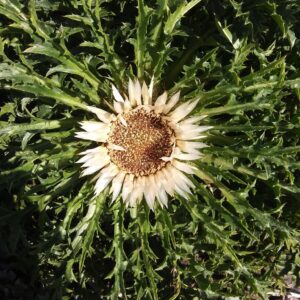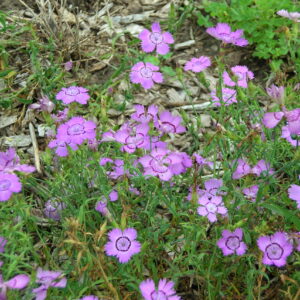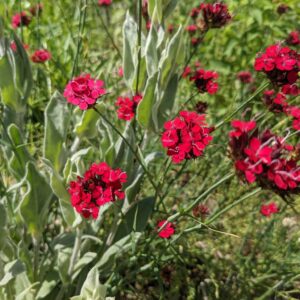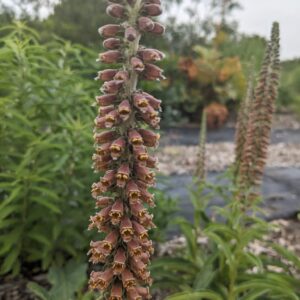"New" Heirloom Plants
Showing 9–16 of 62 results
-
Carlina acaulis ssp. simplex Silver thistle, Weather thistle Z 3-9
Wide, white saucer flowers above silvery thistle foliage, open on dry days, closed in the evenings and on rainy days. July- September
Wide, white saucer flowers above silvery thistle foliage, open on dry days, closed in the evenings and on rainy days. July- September
Size: 6-12” x 12”
Care: sun in well-drained soil.
Native: Southern & Eastern Europe
Wildlife Value: attracts honey-beesThe Genus comes from Charles (Carolus). According to medieval folklore Charlemagne used this root to cure the ills of his troops.
-
Centaurium scilloides Carpet tulip, Perennial centaury Z 5-9
Sweetest plant ever - tiny pink tulip-like flowers in constant bloom mid-summer to frost, close at night and open in daytime
OUT OF STOCK
Sweetest plant ever – tiny pink tulip-like flowers in constant bloom mid-summer to frost, close at night and open in daytime
Size: 2” x 4”
Care: sun to part shade in moist to moist well-drained soil
Native: Atlantic Ocean coasts of Europe, AzoresNamed by Carl Linnaeas the Younger in the supplement to his father’s legendary book Species Plantarum, 1782
-
Clematis occidentalis var. occidentalis Purple clematis. Short-styled bluebell Z 4-8
Four petaled (sepals), purple, down-facing, 4” long bells flowering in spring encircling a bundle of styles and stamens.
OUT OF STOCK – EMAIL FOR AVAILABILITY
Four petaled (sepals), purple, down-facing, 4” long bells flowering in spring encircling a bundle of styles and stamens.
Size: 3-12” x 2’
Care: sun to shade in moist well-drained to well-drained, alkaline soil
Native: Maine to Minnesota south to Illinois and South Carolina and all states between, Wisconsin native. Endangered in three states; “of special concern” in Wisconsin and gone in Ohio.The species first described by Danish botanist Jens Wilken Hornemann in 1805. var. occidentalis is the eastern variety of the species (peculiarly called occidentalis meaning west.) The species and other varieties are native in western US.
-
Cleome serrulata Rocky Mountain Beeweed, Spiderflower, Stinkweed Reseeding annual
Blooming all summer dozens of rose to lilac-colored flowers bunch together at the top of the 3-4” tall stem seemingly one soft-ball sized flower. Thread-thin stamens protrude above the flowers, each flower bearing six stamens, 72, for example, if the cluster contains a mere dozen individual flowers earning it the nickname spider flower. Short leaves grow the length of plant stems, from bottom to top, bare of flowers. A trio of leaflets to each leaf, one as a leader with two sidekicks.
OUT OF STOCK – EMAIL FOR AVAILABILITY
Blooming all summer dozens of rose to lilac-colored flowers bunch together at the top of the 3-4” tall stem seemingly one soft-ball sized flower. Thread-thin stamens protrude above the flowers, each flower bearing six stamens, 72, for example, if the cluster contains a mere dozen individual flowers earning it the nickname spider flower. Short leaves grow the length of plant stems, from bottom to top, bare of flowers. A trio of leaflets to each leaf, one as a leader with two sidekicks.
Size: 4' x 9"
Care: sun in moist-well drained to dry soil, drought tolerant
Native: Minnesota west to the Pacific, south to Arizona and New Mexico and all in between.
Wildlife Value: : So many flowers, each with nectar and a hoard of stamens each holding pollen in a soft-ball sized object makes this a mecca for pollinators of all sorts, numerous bee species, wasps and several butterflies. When it’s done flowering birds eat its seeds. Its skunk-like odor (Stinkweed) has one advantage – it keeps the deer away.An ancient, pre-historic plant, Natives including Lakota, Zuni, Tewa, Navajo, and Pueblo found many uses for this Cleome. Some ate shoots, leaves, seeds or flowers, cooked them, or ate them raw alone or together with other food. Tewa grew this with corn, beans and squash to attract pollinators to pollinate the food plants. Infusions treated fever, and stomach aches. A poultice treated sore eyes. Lakota used this and a shrub to trap bison. Navajo color rugs with a yellow-green dye they make from Cleome. Pueblo Indians concentrate Cleome to make a thick, black paste to decorate baskets and pottery. Meriwether Lewis collected three of these two on the way west and one homebound traveling east.
-
Coreopsis lanceolata Lanceleaf tickseed Z 4-9
Golden yellow daisy-like flowers with pleated petals, jagged at their tips, blooming June to September
OUT OF STOCK
Golden yellow daisy-like flowers with pleated petals, jagged at their tips, blooming June to September
Size: 24” x 18”
Care: sun to part shade, moist well-drained soil
Native: Central and southeastern U.S., WI native
Wildlife Value: caterpillar food sourceCoreopsis is Greek meaning “buglike” referring to the seeds looking like little black bugs. Cultivated in America since the 1700’s. Sent to England in 1724 by English naturalist Mark Catesby (1683-1749).
-
Dianthus amurensis syn Dianthus chinensis Amur Pink Z 3-8
Five jagged-edged petals on its plum-purple blossoms, not pink, as are all other “pinks, the common name for Dianthus. It also flowers later and longer than most other Dianthus, flowering most of the summer. Its uniform purple stamens meld into the flower’s view but a thin, deep purple line encircles the center.
Five jagged-edged petals on its plum-purple blossoms, not pink, as are all other “pinks, the common name for Dianthus. It also flowers later and longer than most other Dianthus, flowering most of the summer. Its uniform purple stamens meld into the flower’s view but a thin, deep purple line encircles the center.
Size: 12" x 12"
Care: Sun in well-drained soil
Native: Amur River regionAmurensis means from the Amur River (flows between the boundaries of China and Russia.)
Re-named, separated from Dianthus chinensis, by French nurseryman and hybridizer Henri Antoine Jacques (1782–1866), best known for his creation of the Bourbon rose, in 1861 in Journal de la Société Impériale et Centrale d’Horticulture 7: 625. 1861 -
Dianthus cruentus Blood pink Z 5-9
Small but eye-catching carmine flowers held high on a leafless stem above basal foliage. Blooms in late spring-early summer
Small but eye-catching carmine flowers held high on a leafless stem above basal foliage. Blooms in late spring-early summer
Size: 2-3’ x 6-9”
Care: sun in moist well-drained soil
Native: Balkans
Wildlife Value: Attracts bees & butterfliesFirst described in Spic. Fl. Rumel. 1: 186 1843.
-
Digitalis parviflora Chocolate foxglove Z 3-9
Spikes densely encircled with small, red-brown bells for weeks in summer, prune back after flowering to encourage reflowering.
OUT OF STOCK
Spikes densely encircled with small, red-brown bells for weeks in summer, prune back after flowering to encourage reflowering.
Size: 24- 60” x 12”
Care: sun to part shade in moist well-drained to well-drained soil
Native: Picos de Europa Mountains of Northern Spain
Wildlife Value: attracts bees and butterflies for its pollen and nectar, deer and rabbit resistant.
Awards: Royal Horticultural Society Award of Garden MeritGrown by Tradescant the Elder, 1634.





